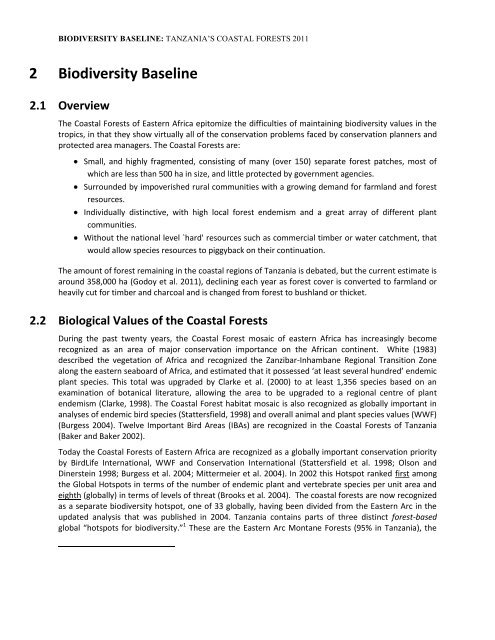Neil D. Burgess, Paul Harrison, Peter Sumbi, James Laizer, Adam ...
Neil D. Burgess, Paul Harrison, Peter Sumbi, James Laizer, Adam ...
Neil D. Burgess, Paul Harrison, Peter Sumbi, James Laizer, Adam ...
You also want an ePaper? Increase the reach of your titles
YUMPU automatically turns print PDFs into web optimized ePapers that Google loves.
BIODIVERSITY BASELINE: TANZANIA’S COASTAL FORESTS 2011<br />
2 Biodiversity Baseline<br />
2.1 Overview<br />
The Coastal Forests of Eastern Africa epitomize the difficulties of maintaining biodiversity values in the<br />
tropics, in that they show virtually all of the conservation problems faced by conservation planners and<br />
protected area managers. The Coastal Forests are:<br />
Small, and highly fragmented, consisting of many (over 150) separate forest patches, most of<br />
which are less than 500 ha in size, and little protected by government agencies.<br />
Surrounded by impoverished rural communities with a growing demand for farmland and forest<br />
resources.<br />
Individually distinctive, with high local forest endemism and a great array of different plant<br />
communities.<br />
Without the national level `hard' resources such as commercial timber or water catchment, that<br />
would allow species resources to piggyback on their continuation.<br />
The amount of forest remaining in the coastal regions of Tanzania is debated, but the current estimate is<br />
around 358,000 ha (Godoy et al. 2011), declining each year as forest cover is converted to farmland or<br />
heavily cut for timber and charcoal and is changed from forest to bushland or thicket.<br />
2.2 Biological Values of the Coastal Forests<br />
During the past twenty years, the Coastal Forest mosaic of eastern Africa has increasingly become<br />
recognized as an area of major conservation importance on the African continent. White (1983)<br />
described the vegetation of Africa and recognized the Zanzibar-Inhambane Regional Transition Zone<br />
along the eastern seaboard of Africa, and estimated that it possessed ‘at least several hundred’ endemic<br />
plant species. This total was upgraded by Clarke et al. (2000) to at least 1,356 species based on an<br />
examination of botanical literature, allowing the area to be upgraded to a regional centre of plant<br />
endemism (Clarke, 1998). The Coastal Forest habitat mosaic is also recognized as globally important in<br />
analyses of endemic bird species (Stattersfield, 1998) and overall animal and plant species values (WWF)<br />
(<strong>Burgess</strong> 2004). Twelve Important Bird Areas (IBAs) are recognized in the Coastal Forests of Tanzania<br />
(Baker and Baker 2002).<br />
Today the Coastal Forests of Eastern Africa are recognized as a globally important conservation priority<br />
by BirdLife International, WWF and Conservation International (Stattersfield et al. 1998; Olson and<br />
Dinerstein 1998; <strong>Burgess</strong> et al. 2004; Mittermeier et al. 2004). In 2002 this Hotspot ranked first among<br />
the Global Hotspots in terms of the number of endemic plant and vertebrate species per unit area and<br />
eighth (globally) in terms of levels of threat (Brooks et al. 2004). The coastal forests are now recognized<br />
as a separate biodiversity hotspot, one of 33 globally, having been divided from the Eastern Arc in the<br />
updated analysis that was published in 2004. Tanzania contains parts of three distinct forest-based<br />
global “hotspots for biodiversity.” 1 These are the Eastern Arc Montane Forests (95% in Tanzania), the

















